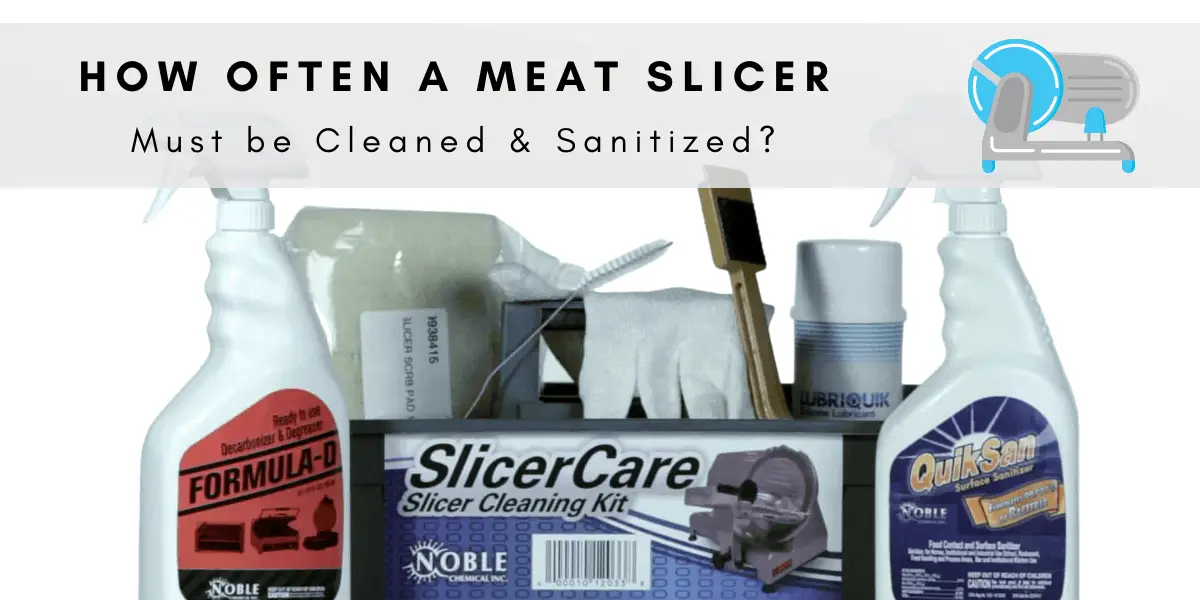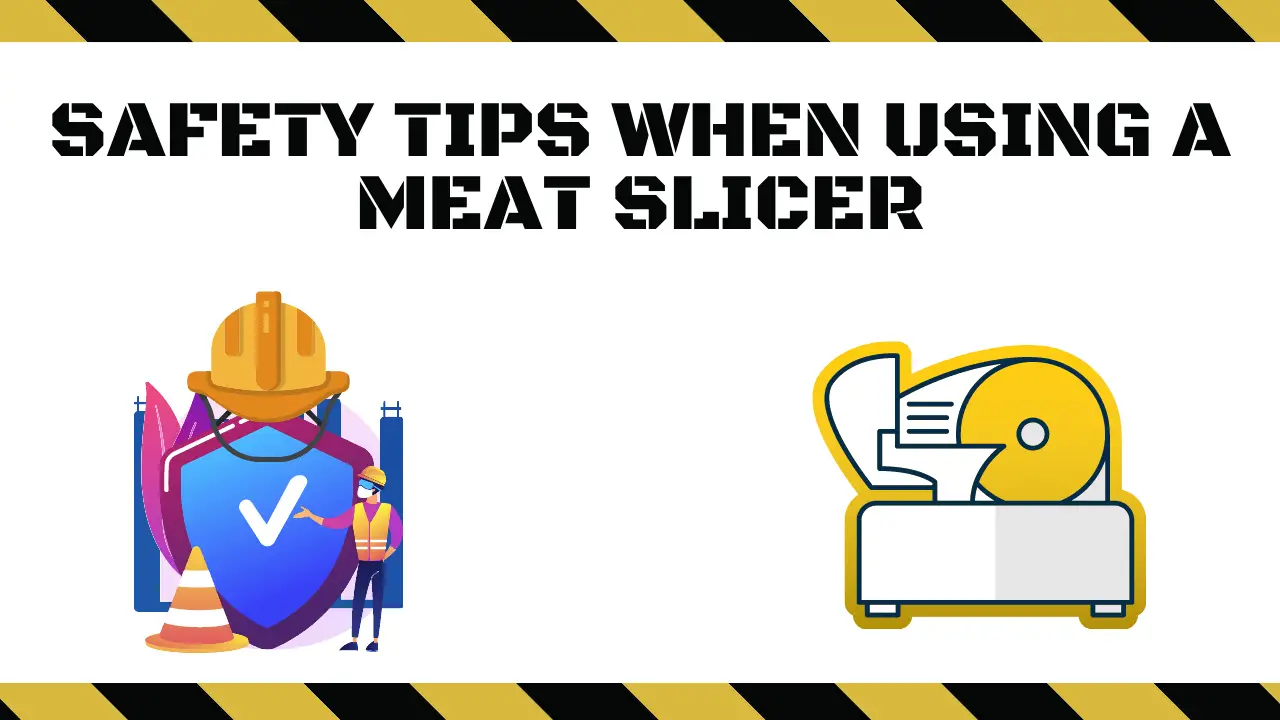Sanitary practices are crucial when cutting meat and cold cuts to ensure food safety. Regularly clean and sanitize kitchen equipment, particularly meat slicers, to prevent contamination and the spread of harmful bacteria. Follow the seven steps of cleaning a meat slicer: dry clean, scrape, rinse, wash, rinse again, disinfect, and allow to dry. Additionally, conduct deep cleaning at the end of each day. Promptly rinse equipment after use, use appropriate cleaning tools, and pay attention to problematic areas. Remember, proper sanitation is essential for the safety of both employees and customers.
Importance of Cleaning Kitchen Equipment for Food Safety
Maintaining cleanliness and practicing proper sanitation procedures are of utmost importance in any kitchen, particularly when it comes to handling meat and cold cuts. Here’s why it matters:
Machinery may harbor pathogenic organisms:
Some kitchen equipment, including meat slicers, can accumulate harmful bacteria and contaminants if not cleaned regularly. Pathogens may hide in joints, narrow crevices, and other hard-to-reach areas, potentially leading to foodborne illnesses.
Compliance with food safety regulations:
Food safety authorities, such as the FDA, have established strict guidelines for cleaning kitchen equipment and facilities. Compliance ensures the safety of employees and customers who consume the products.
Prevention of cross-contamination:
Meat slicers frequently handle various batches of raw meats, making them prone to debris accumulation and bacterial growth. A thorough cleaning helps prevent cross-contamination between different food items and maintains hygiene standards.
Steps to Clean a Meat Slicer:
Proper cleaning of a meat slicer is crucial for maintaining food safety standards. Follow these seven steps to effectively clean and sanitize your meat slicer:
Dry clean the work area: Remove all meat pieces, paper, and other debris from the work surface.
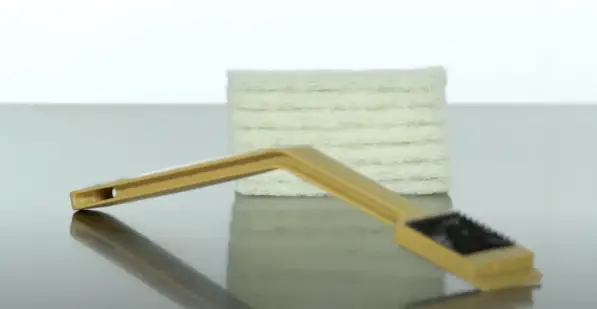
Scrape the equipment: Use a rubber scraper to remove as much debris as possible from the slicer’s surfaces.
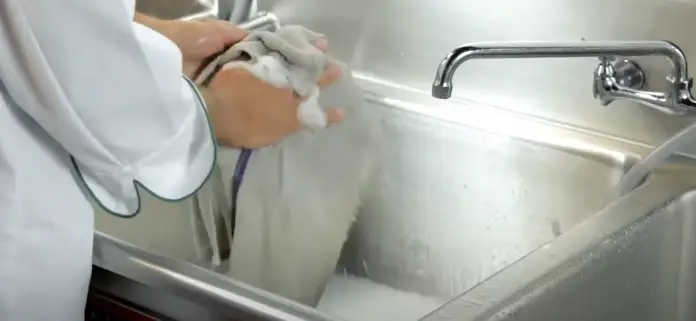
Rinse with lukewarm water: Thoroughly rinse all surfaces with lukewarm water (around 40-50 degrees) to remove any remaining residue.
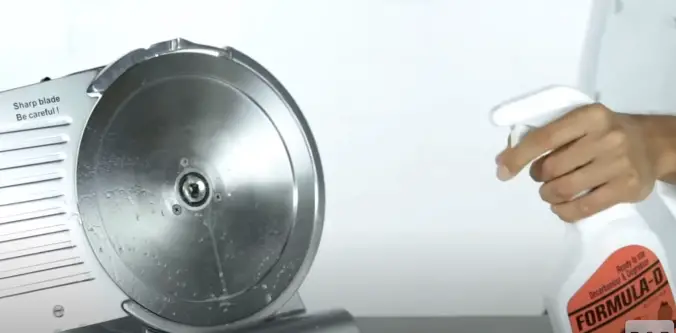
Wash with an alkaline solution: Use an alkaline cleaning solution and a brush to clean all parts of the meat slicer thoroughly.
Rinse with hot water: Rinse all surfaces with hot water (around 80 degrees) to eliminate any remaining cleaning solution or residue.
Disinfect with a chemical solution: Apply a recommended disinfecting solution to sanitize the meat slicer. Follow the manufacturer’s instructions for the appropriate contact time.
Allow to dry: Let the meat slicer air dry or use a clean rubber scraper to remove excess water.
Tips to Facilitate Cleaning and Sanitation
Keeping your meat slicer clean and sanitary is essential for food safety. Here are some detailed tips to make the cleaning and sanitation process more effective:
Rinse equipment promptly:
After each use, rinse the meat slicer promptly to prevent food debris from hardening and becoming difficult to remove. This will make the cleaning process easier and more efficient.
Use appropriate cleaning tools:
When cleaning hand tools or the meat slicer, utilize a multi-compartment sink or sterilization unit. These dedicated areas ensure proper cleaning and prevent cross-contamination between different utensils or equipment.
Use bristle brushes for effective cleaning:
Opt for bristle brushes instead of metal sponges or abrasive pads when cleaning your meat slicer. Bristle brushes are effective in removing debris without scratching the metal surfaces, maintaining the slicer’s integrity.
Avoid using cloths and sponges:
Cloths and sponges can harbor bacteria and contribute to cross-contamination. Instead of using them, use clean, wet towels for rinsing surfaces. These towels can be easily cleaned and sanitized after each use.
Frequency of Cleaning a Meat Slicer
The frequency of cleaning and sanitizing a meat slicer depends on its usage. Here are some recommendations:
Constant use (every 4 hours):
According to the FDA Food Code, meat slicers should be cleaned and sanitized every 4 hours when in constant use. This prevents debris from hardening and ensures food safety.
Shift change and stuck food removal:
Light cleaning can be performed during shift changes to remove any stuck food debris, ensuring efficient operation.
Deep cleaning (end of the day):
For thorough maintenance, perform a deep cleaning at the end of each working day. This involves disassembling the slicer, rigorous washing, and sanitizing of all parts.
Deep Cleaning a Meat Slicer at the End of the Day
Performing a deep cleaning of your meat slicer at the end of the day is essential for maintaining food safety and preventing the buildup of harmful bacteria. For a comprehensive deep cleaning:
Unplug the meat slicer:
Before beginning the cleaning process, ensure that the meat slicer is not operating by unplugging it from the power source. This step is crucial for safety.
Remove large food residues:
Take a clean paper towel and use it to remove any visible food residues from the slicer’s surfaces. This step helps in preparing the slicer for thorough cleaning.
Disassemble the slicer:
Refer to the manufacturer’s manual or guidelines to properly disassemble the entire meat slicer. Take note of the specific instructions for your model to avoid any damage during the disassembly process.
Wash dismantled parts:
Once the slicer is disassembled, bring all the dismantled parts to a sink with a prepared cleaning solution. Ensure the cleaning solution is suitable for the materials used in your meat slicer. Thoroughly wash all the parts, including the blade, tray, guards, knobs, and any other removable components. Use a brush or sponge to scrub away any food residues or buildup.
Apply sanitizing spray:
After washing all the parts, apply a meat slicer sanitizing spray to ensure thorough sanitization. Make sure all the surfaces are adequately covered with the sanitizing spray. If the sanitizer does not require rinsing, allow it to dry on the surfaces as per the instructions on the product label. If rinsing is required, rinse the parts with clean water.
Clean the main machine unit:
Focus on the main machine unit, which includes the motor, handle, joints, gaskets, and any other non-removable parts. Use a brush or sponge to clean these areas thoroughly. Pay extra attention to remove any stuck food debris or buildup from these hard-to-reach areas.
Rinse with hot water:
Rinse all the parts and surfaces that can be washed with hot water. This step helps to remove any remaining residue or cleaning solution from the slicer.
Apply sanitizing solution:
After rinsing, apply a recommended sanitizing solution to all the washed surfaces. Follow the instructions provided with the sanitizer for the appropriate contact time to ensure effective sanitization.
Air-dry the unit:
Once the sanitizing solution has been applied, allow the main motor unit and all the cleaned parts to air-dry completely. Ensure that there is no excess moisture before reassembling the meat slicer.
Problematic Areas to Clean on a Meat Slicer
Certain areas of a meat slicer require extra attention during cleaning due to food particle accumulation. Focus on these areas during deep cleaning:
- Slicer blade: Disassemble and clean the slicer blade thoroughly, ensuring all crevices and surfaces are free from debris.
- Gaskets and joints: Pay close attention to gaskets and joints, as they often collect food particles. Clean these areas diligently.
- Slicer handle, blade guard, and ring guard: These parts can accumulate food debris and are harder to clean. Disassemble as necessary and use brushes to reach difficult-to-clean areas.
FAQs:
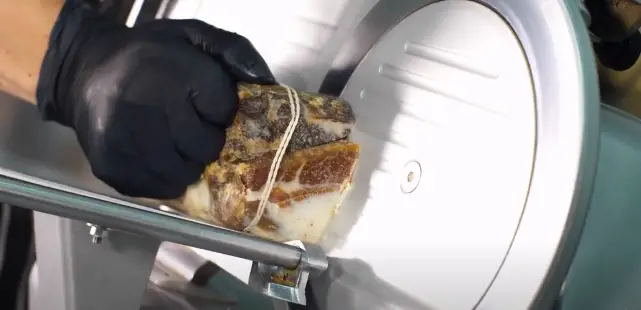
Can You Cut Frozen Meat with a Meat Slicer?
While a meat slicer can handle smaller cuts of frozen meat, it’s important to consider the slicer’s maximum capacity. Larger pieces of frozen meat may require prior breakdown before slicing.
How to Clean a Deli Slicer?
Cleaning a deli slicer, also known as a meat slicer, follows similar principles to cleaning any other meat slicer. Use a clean cloth, soapy water, and sanitizer for effective cleaning and sanitization.
How often should I rinse the meat slicer after use?
It is best to rinse the meat slicer shortly after each use to prevent food debris from hardening and becoming difficult to remove.
What tools should I use for cleaning a meat slicer?
Utilize a multi-compartment sink or sterilization unit for hand tools. Use bristle brushes instead of metal sponges or abrasive pads to avoid scratching metal surfaces.
Should I use separate cutting boards for raw meat and fresh produce?
Yes, it is recommended to use one cutting board specifically for fresh produce and a separate one for raw meat, poultry, and seafood. This helps prevent cross-contamination between different types of food.
Can I place cooked food on a plate that previously held raw meat, poultry, seafood, or eggs?
No, it is not safe to place cooked food on a plate that previously held raw meat, poultry, seafood, or eggs unless the plate has been washed in hot, soapy water. This prevents any potential contamination from the raw ingredients.
Can I reuse marinades that were used on raw foods?
It is not advisable to reuse marinades that were used on raw foods unless you bring them to a boil first. This is to ensure that any potential bacteria from the raw ingredients are killed before using the marinade again.
What are the safety precautions for using a meat slicer?
Never hand-feed or apply hand pressure when placing food into the slicer. Use a pushing/guarding device with chute-fed slicers.
Utilize plungers or the feeding attachment located on the food holder to feed food into chute-fed slicers.
Always turn off the food slicer when changing foods to avoid any accidental injuries or mishaps.
Conclusion: Prioritize Sanitary Practices for Safe Meat Cutting
Maintaining sanitary practices when cutting meat and cold cuts is essential to ensure food safety. Regularly cleaning and sanitizing kitchen equipment, particularly meat slicers, reduces the risk of contamination and keeps the end products safe for consumption. By following the recommended steps and best practices, you can protect both your employees and customers, providing them with a clean and wholesome culinary experience.
Key Takeaways:
- Proper cleaning and maintenance of equipment, like meat slicers, comply with sanitary regulations and prevent contamination.
- Machines in the kitchen can harbor harmful bacteria and require regular cleaning to maintain food safety.
- Seven steps for effective meat slicer cleaning: dry clean, scrape, rinse, wash, rinse again, disinfect, and allow to dry.
- Rinse equipment promptly, use appropriate cleaning tools, and conduct regular deep cleaning for thorough maintenance.
- Cleaning and sanitizing a meat slicer every 4 hours during constant use is recommended.
- Deep clean a meat slicer at the end of each working day, disassembling the unit and thoroughly washing all parts.
- Pay special attention to problematic areas, such as the slicer blade, gaskets, joints, handle, blade guard, and ring guard.
- Smaller cuts of frozen meat can be sliced using a meat slicer, but larger pieces may require prior breakdown.
- Use a clean cloth, soapy water, and sanitizer when cleaning a deli slicer or meat slicer.

John Hebdon is a food enthusiast, passionate chef, and author of various articles and blog posts related to food and cooking. With a deep love for all things culinary, John’s blog serves as a platform to share his extensive kitchen experiences with a broader audience.
In addition to his culinary expertise, John has a flair for writing and a natural ability to share his passion for food with others. His articles and blog posts are informative, engaging, and packed with practical tips for readers of all skill levels.
As a food enthusiast and writer, John is always on the lookout for new and exciting culinary experiences. Whether it’s trying out a new restaurant, experimenting with a new recipe, or simply sharing a favorite dish with friends and family, John is always eager to explore and share the world of food with others.

